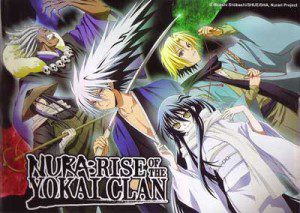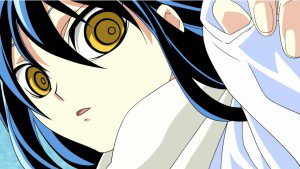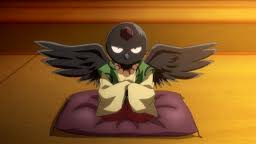 Remember how a few years ago shinigami were all the rage? Well, times change, and so does the mangaverse. Where one day there were death gods galore, recently I’ve noticed a huge upswing in another lovely creation of the Japanese folklore experience, albeit an older and more developed one. Yes fellows, the time of the Yokai has come, and we have nothing to do but fear it. But fear it in a good way.
Remember how a few years ago shinigami were all the rage? Well, times change, and so does the mangaverse. Where one day there were death gods galore, recently I’ve noticed a huge upswing in another lovely creation of the Japanese folklore experience, albeit an older and more developed one. Yes fellows, the time of the Yokai has come, and we have nothing to do but fear it. But fear it in a good way.
Lately I’ve had a chance to catch up on some of the yokai related series floating around, and today I’d like to write a bit about one of the manga I’ve been enjoying. Though it was initially released in 2008, Nura: Rise of the Yokai Clan was only recently released in the United States through Viz media. And with four volumes of the manga currently available, plus the first season of the anime through their website, I thought I would share some of my views and impressions on this series. Nura follows the life of middle school student Rikuo Nura, a bespectacled, curious boy who just happens to be the grandson of Nurarihyon, the Supreme Commander of Pandemonium and leader of the “ruling syndicate” of the yokai. He lives in an old mansion, half decrepit, half fancy, and completely full of yokai loyal to his grandfather, and by extension, to him. As a boy, Rikuo is so accustomed to the presence of the yokai in his life that he cannot see them as anything but friendly and funny “family members.” This notion is challenged one day by a haughty fellow student, Kiyotsugu, who insists that yokai not only are evil, but that they don’t exist. (Technically Kiyotsugu is half right, yokai aren’t saints by any stretch of the imagination.)
 When he steps up to defend the yokai he has lived with all his life, the ridicule leads him to suddenly stop trying to embrace his heritage as the descendant of Nurarihyon, and focus on being all human, all the time. But there’s a little catch to this assertion. See, whenever his friends are threatened, Rikuo transforms into a powerful yokai, a modern Nurarihyon, in order to combat the threat. While in this form, he is powerful, fast and barely resembles the human boy he is by day. Unfortunately, he also seems to forget that he can become this yokai when he reverts back to plain little Rikuo. This becomes a major issue later on in the early volumes, because the yokai Rikuo is determined to succeed his grandfather as “The Third” supreme commander, while the human Rikuo could care less. This conflict of interests eventually becomes a major plot point in the series (at least through volume 3), and leads the Nura syndicate to appear weak in the face of encroachment from other yokai clans.
When he steps up to defend the yokai he has lived with all his life, the ridicule leads him to suddenly stop trying to embrace his heritage as the descendant of Nurarihyon, and focus on being all human, all the time. But there’s a little catch to this assertion. See, whenever his friends are threatened, Rikuo transforms into a powerful yokai, a modern Nurarihyon, in order to combat the threat. While in this form, he is powerful, fast and barely resembles the human boy he is by day. Unfortunately, he also seems to forget that he can become this yokai when he reverts back to plain little Rikuo. This becomes a major issue later on in the early volumes, because the yokai Rikuo is determined to succeed his grandfather as “The Third” supreme commander, while the human Rikuo could care less. This conflict of interests eventually becomes a major plot point in the series (at least through volume 3), and leads the Nura syndicate to appear weak in the face of encroachment from other yokai clans.
As a manga, Nura feels a lot like Bleach at times. There are definite parallels between the stories of Rikuo Nura and Ichigo Kurosaki in the early volumes, as they come to grips with their newfound powers. There is also a heavy amount of fighting going on as the stories progress, imitating the now classic theme found within boys battle manga. While not identical, the art styles are definitely similar enough at times, with page wide spreads of attacks that are hard to discern on their own but still very flashy and visibly appealing. And Rikuo, while not exactly Ichigo all the time, does become a very arrogant warrior when his powers manifest. Were this the main selling point of “Rise of the Yokai Clan,” I probably would have put the manga down and stopped caring. But leave it to creator Hiroshi Shiibashi to make the series interesting by adding to it a healthy dose of Japanese folklore.
 Anyone with even a passing interest or knowledge of yokai will find this series an interesting tweak on source mythology. Most, if not all, of the major yokai are presented here in quirky fashion. Karasu-tengu, historically a wise crowlike yokai capable of playing tricks while kicking serious ass, is shown here as a tiny black bird who keeps order among the various members of the household. Yuki-onna, the Ice Queen, who steals breath from the living in order to keep warm, is a bubbly girl about Rikuo’s age who follows him round waving flags, cooking dinner, and acting like a “big sister.” The Bakeneko clan, traditionally ghostly cats who run the gamut of helpful to hurtful, are gambling trickster spirits who run the “red light district” in Rikuo’s home town (known as Ukiyoe town, a tribute to the old style of Japanese woodcuts known as ukiyo-e, of which a great many yokai images were created). And the Kappa, a water goblin who prowls the shores and rivers of Japan to this day, lives in the pond out behind the Nura mansion. Indeed, Shiibashi takes a lot of liberties with his sources over the course of the manga, keeping the powers (and sometimes personality) of the yokai he chooses to incorporate into the story, while infusing them with personality quirks and traits that make them more comical than scary.
Anyone with even a passing interest or knowledge of yokai will find this series an interesting tweak on source mythology. Most, if not all, of the major yokai are presented here in quirky fashion. Karasu-tengu, historically a wise crowlike yokai capable of playing tricks while kicking serious ass, is shown here as a tiny black bird who keeps order among the various members of the household. Yuki-onna, the Ice Queen, who steals breath from the living in order to keep warm, is a bubbly girl about Rikuo’s age who follows him round waving flags, cooking dinner, and acting like a “big sister.” The Bakeneko clan, traditionally ghostly cats who run the gamut of helpful to hurtful, are gambling trickster spirits who run the “red light district” in Rikuo’s home town (known as Ukiyoe town, a tribute to the old style of Japanese woodcuts known as ukiyo-e, of which a great many yokai images were created). And the Kappa, a water goblin who prowls the shores and rivers of Japan to this day, lives in the pond out behind the Nura mansion. Indeed, Shiibashi takes a lot of liberties with his sources over the course of the manga, keeping the powers (and sometimes personality) of the yokai he chooses to incorporate into the story, while infusing them with personality quirks and traits that make them more comical than scary.
He also takes pride in creating his own yokai, like the -tabo “twins” Aotabo and Kurotabo, themselves powerful warriors (and former monks) who became yokai in life and now serve the syndicate faithfully. Indeed, this idea that humans can transform into yokai is a central part of the overarching plot of the series (and the main focus of Rikuo’s development as a character) and serves to add a sense of humanity to characters whose primary motivation in folklore is to scare people. Also impressively, Shiibashi spares little when designing the yokai forms, incorporating a lot of art styles that go right back to Toriyama Sekien, who illustrated one of the first manuals on yokai a few centuries back. (He even uses recreations of some of Sekien’s own illustrations at times when introducing major yokai “mover and shakers” into the story.)
 For those interested in the idea of yokai (or who love to look at them), Nura is an entertaining introduction and imagining of yokai tales. Indeed, this is its main appeal, and offers enough material and monsters to keep the series running for a long time. The art suits the story, which itself is a little predictable in the end, but still enjoyable nonetheless.
For those interested in the idea of yokai (or who love to look at them), Nura is an entertaining introduction and imagining of yokai tales. Indeed, this is its main appeal, and offers enough material and monsters to keep the series running for a long time. The art suits the story, which itself is a little predictable in the end, but still enjoyable nonetheless.


[…] this idea of part-human youkai isn’t exactly new. Last summer I wrote a review of Nurarihyon no mago, a manga where the protagonist is part youkai trying to retain command over his grandfather’s […]
[…] this idea of part-human youkai isn’t exactly new. Last summer I wrote a review of Nurarihyon no mago, a manga where the protagonist is part youkai trying to retain command over his grandfather’s […]